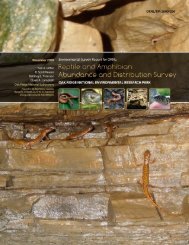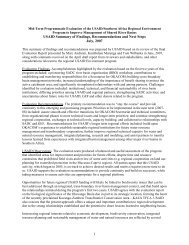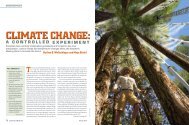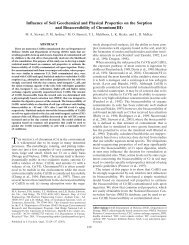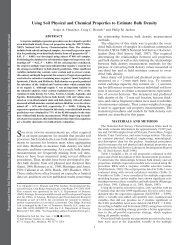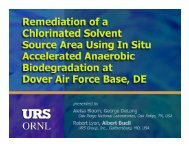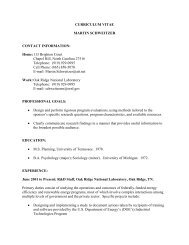oak ridge reservation physical characteristics and natural resources
oak ridge reservation physical characteristics and natural resources
oak ridge reservation physical characteristics and natural resources
You also want an ePaper? Increase the reach of your titles
YUMPU automatically turns print PDFs into web optimized ePapers that Google loves.
Studies conducted by wildlife biologist Stanley Temple indicate that the edge effect extends into<br />
a forest as much as 219 yd (200 m) (Temple <strong>and</strong> Cary 1988). Thus, researchers have used this<br />
distance as a criterion for identifying “interior” forest areas that would remain unaffected by forest<br />
fragmentation. When the 219-yd (200-m) buffer area is taken into consideration, the true nonimpacted<br />
interior forest could be eliminated or reduced to very small <strong>and</strong>/or narrow areas when encroached<br />
upon by surrounding roads, power-line corridors, <strong>and</strong> other openings. The ORR currently supports<br />
about 4100 acres (1659 ha) of interior forest. This acreage will decrease in certain areas of the<br />
<strong>reservation</strong> with additional clearing for new buildings <strong>and</strong> new roads <strong>and</strong> as a result of further roadwidening<br />
projects.<br />
An important barometer in the determination of forest habitat quality is the presence of certain<br />
neo-tropical migrant bird species. These species are impacted by decreases in acreage <strong>and</strong> the<br />
fragmentation of forest habitats. Fortunately, the ORR continues to support many such species,<br />
including the Acadian flycatcher, ovenbird, hooded warbler, northern parula, Kentucky warbler, <strong>and</strong><br />
Louisiana water thrush.<br />
Continued fragmentation of forest habitat on the ORR will result in the loss of species such as<br />
those noted above. Exercising care concerning road placement, minimizing road widenings, <strong>and</strong><br />
allowing the forest canopy to close over existing roads will help mitigate impacts on interior forest<br />
<strong>resources</strong>.<br />
10. WETLANDS<br />
The ecological functioning of approximately 580 acres (235 ha) of wetl<strong>and</strong>s known to date on<br />
the ORR provides water-quality benefits, stormwater control, wildlife habitat, rare-species habitat,<br />
<strong>and</strong> l<strong>and</strong>scape <strong>and</strong> biological diversity (Fig. 6).<br />
Wetl<strong>and</strong>s occur across the ORR at low-elevation positions, primarily in the riparian zones of<br />
headwater streams <strong>and</strong> their receiving streams, as well as in Clinch River embayments. Most of the<br />
wetl<strong>and</strong>s on the ORR are classified as palustrine forested, scrub-shrub, <strong>and</strong> emergent wetl<strong>and</strong>s<br />
(Cowardin et al. 1979). Wetl<strong>and</strong>s identified to date range in size from several square yards at small<br />
seeps <strong>and</strong> springs to approximately 25 acres (10 ha) at White Oak Lake. A high percentage of the<br />
wetl<strong>and</strong>s on the ORR encompass less than 1 acre (1/2 ha) <strong>and</strong> occur in headwater areas. Wetl<strong>and</strong>s<br />
greater than 1 acre (0.4 ha) are typically associated with river embayments, other areas affected by the<br />
fluctuating water levels of the Clinch River reservoirs (e.g., Poplar Creek), areas in which water has<br />
been artificially impounded (e.g., White Oak Lake), <strong>and</strong> beaver ponds.<br />
Activities that affect wetl<strong>and</strong>s are regulated under federal law (Sect. 404 of the Clean Water Act,<br />
Federal Water Pollution Control Act, 33 USC 1251) <strong>and</strong> state law (Tennessee Water Quality Control<br />
Act, TN Code Annotated 70-324). Federal <strong>and</strong> state permits are required to conduct dredge-<strong>and</strong>-fill<br />
activities in a jurisdictional wetl<strong>and</strong> (i.e., an area that meets the criteria established by the U.S. Army<br />
Corps of Engineers for a wetl<strong>and</strong>). Impacts to wetl<strong>and</strong>s are avoided whenever possible. If impacts are<br />
unavoidable, they are minimized through steps such as project design changes or the implementation<br />
of best management practices. Compensatory mitigation in the form of wetl<strong>and</strong> restoration, creation,<br />
or enhancement is a required permit condition under certain circumstances.<br />
11. CULTURAL RESOURCES<br />
Cultural <strong>resources</strong> on the ORR include (1) surface <strong>and</strong> buried archaeological materials (artifacts)<br />
<strong>and</strong> sites dating to the prehistoric, historic, <strong>and</strong> ethnohistoric periods; (2) st<strong>and</strong>ing structures that are<br />
more than 50 years old or, if newer, are important because they represent a major historical theme or<br />
era; (3) cultural <strong>and</strong> <strong>natural</strong> places, selected <strong>natural</strong> <strong>resources</strong>, <strong>and</strong> objects with importance for Native<br />
Americans; <strong>and</strong> (4) American folklife traditions <strong>and</strong> arts. Six properties on the ORR are included in<br />
the National Register of Historic Places: (1) Oak Ridge Turnpike Checking Station, (2) Bear Creek<br />
23




